Menus
- Three levels of traction control, disconnectable ABS, DCT: useful, or not ?
- A life-size test at the Honda Adventure Center in Wales
- Grip and maneuverability
- Electronics put to the test
- The 1000-franc question: DCT or manual ?
- Conclusion
Three levels of traction control, disconnectable ABS, DCT: useful, or not ?
A life-size test at the Honda Adventure Center in Wales
A real commercial success, the Honda CRF 1000L Africa Twin has already sold more than 9,000 copies in Europe in just a few months of marketing.. It arrives in a very crowded niche, since everyone or almost everyone is on trail fashion and even Ducati produces an unlikely, although successful, Enduro version of its Multistrada, which is not without asking a real question: do you need 160 horses to go logging on the roads ?
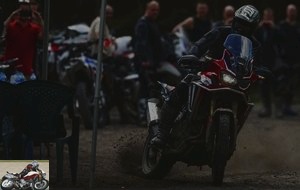
Notwithstanding this pure philosophical debate which will inevitably find followers in both camps, it is clear that Honda, faithful to its philosophy of "total control" initiated by the CBR 900 and its designer, Tadao Baba, in 1992, did not wanted to enter the race for power.
The proof: its new engine, a 998 cm3 in-line twin, produces "only" 95 horsepower, a power quite far from the 125 horsepower of that which was until then the queen of the category, the BMW R 1200 GS. And so let’s not talk about the hyperpower of the Multistrada Enduro or the BMW S1000XR.
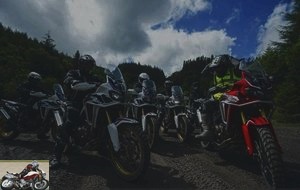
The Africa Twin’s philosophy is different: pragmatism trumps overbidding. This Africa Twin has already been tested in detail at Le Repaire by my colleague the wonderful Damien during intensive driving in South Africa where it was able to show off its qualities. The following is therefore a further test: since the Africa Twin claims to be a real trail, we put it to the test in the thick and muddy forests of Wales, on Honda’s 200 hectares of trails. Adventure Center and with a four-time Motocross World Champion, Dave Thorpe, as instructor. What better understand the capacities of the machine in a different environment and closer to the conditions that we meet in our region. For the occasion, the Africa Twin is equipped with a Metzeler Karoo 3 train, suitable for this use.
Grip and maneuverability
It is rather thin and high, the Africa Twin, with its 2.33 m long and 1.47 m high. It can intimidate, with its 232 kilos (all full facts), a value that goes up to 242 kilos with the DCT dual-clutch transmission. The saddle height, which can be adjusted to 850 or 870 mm, does away with the less tall of our fellow citizens. Let’s say that below 1.70 m in height, the pilot will feel a little high up. Nevertheless, the bike remains thin at the level of the tank, the handlebars are well designed and the generous notched footrests promise to be of some help once we get into the fat..
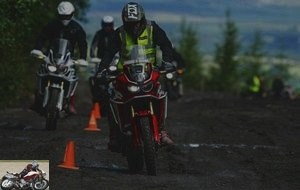
The first exercises of this introductory course in driving a big off-road trail on soft ground allow you to refine the grip: in first or second, in a standing position, the idea is to influence on the footrests, just to figure out how to keep directional power when the front starts to slip away. In these conditions, what stands out first is the excellent balance of the machine and its self-stability, even at very low speeds, when it comes to turning tight between cones while feeling the front. slip a bit into a muddy puddle. The balance of the machine is then, obviously, part of its qualities, going hand in hand with the smoothness, the reactivity and the progressiveness of the controls to manage an advance to the millimeter without losing the balance..
Electronics put to the test
Before letting us face the paths, the instructors make us do another exercise: a dynamic start by testing the reactivity of each of the 3 levels of traction control, then a final one, with it completely deactivated (just one pressure of the left index finger behind the switch). This exercise shows that electronics therefore have this ability to help you: the levels of skating are very different, with an intervention threshold of sensitive electronics from one level to another. Of two things one: depending on what you are looking for, traction or safety, the electronics are sufficiently well calibrated to allow you to avoid the sudden drift of the rear, the one that will rush you in the ditch, or on the contrary, to be able to change direction quickly on a gas stroke. On the handlebars, we realize that depending on the desired situation, the bike is literally at your service and that the effectiveness of these mechanical aids is quite impressive..
Once launched into the forest, the Africa Twin lets itself be carried along quietly and, of course without adopting a true crossman attitude, reveals two other essential points of its personality: flexibility, smoothness, torque and good traction capacity. of its in-line twin, as well as the good behavior of its suspensions. Both the fork and the rear shock absorb holes and bumps well without bottoming out or being too loose on rebound.
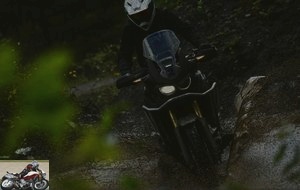
Along the way, difficulties arise. It would be too easy otherwise. And I remember images of WRC rallies in Wales, with this very dark clay mud that sticks well to the tires. Furtively, doubt inhabits me and its icy shadow begins to hover over this Welsh forest, dotted with ferns. It is far, the nearest hospital ?
“Take your traction control level down!” Our instructors tell us. "It’s up to you depending on your sensitivity, but set it to 2 or 1". It is obvious that the 3 would leave us there with the ignition in permanent micro-cuts, so I prefer to play it with my belt and suspenders to attack this very greasy climb, which follows a tight turn, at the bottom of the hill, that we take in a puddle of mud: it’s annoying enough to gain momentum. I arrive, I manage the loss of grip, I aim for the top of the hill and gas! The Africa Twin begins to climb, the Metzeler Karoo 3 grips, finds grip on the few rare stones. In the middle of the hill, unfortunately, the ignition cuts are more present and the bike struggles to move forward. It is too much: despite the DCT, it stalls! I then lower the traction control level to 1. Full throttle, the Africa Twin then sets off again, picks up speed, the rear wheel slips away but I keep the course on the handlebars and then appear the top of the hill .. . Victoire ? No, let’s say rather a nice demonstration of how electronics can be at your side; on condition that you choose the right mode beforehand, because changing the setting while driving is not possible.

Two other buttons on the dashboard, in the right reinforcement of the fairing, also make it possible to further refine the settings of the motorcycle. The first is the ABS: by pressing the button, the rear is deactivated, which makes it possible to initiate a turn by a slight skidding while keeping this system on the front axle gives the virtual certainty of not never spill under braking, which is a downright reassuring feeling. Even on steep descents and, it should be said once again, covered with an unappetizing mud, I finally found it quite easy to adjust the braking: two fingers on the lever, holding the handlebars firmly, a little pressure on the pedal to initiate the start of a turn with a minimum of drift, the conjunction between well-targeted electronics and high-performance tires never ceases to amaze by the ease with which this motorcycle, of a certain size, is taken in sections difficult. What is certain is that a small part of the "bituminous" users of the Africa Twin must be aware that their machine is capable of such feats..
Then there’s the "G" button, to its right, which disables the DCT version’s anti-dribble clutch, for a more responsive throttle response. Honestly, the operation of this mode did not seem to me to be clearly perceived during my evolutions in the fat because the response of the vertical twin, with or without the DCT, is of great precision and great smoothness..
The 1000-franc question: DCT or manual ?
At the end of a test day where our instructors systematically made us ride with the two versions, my opinion on the question is clear and without appeal. However, some of the testers present swore on the version with clutch: "you understand, to quickly get out of a difficulty, a little clutch and presto!" So yes, probably TT specialists and seasoned pilots will feel able to do more tricks with the version which has a cable on the left stalk..
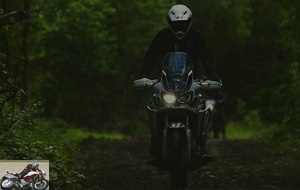
But for others, beginners, occasional practitioners, or simply those seeking greater peace of mind, DCT is a must without hesitation. Its advantages are indeed multiple: small one, we are content to put gas without having to manage the clutch, which allows the left hand to better hold the handlebars. Small two, the 4 transmission modes (Drive, S1, S2, S3) allow you to choose the desired level of mechanical responsiveness which, moreover and this is the small three, can evolve with a quick stroke of the paddle on the handlebars to change gear, for those who want at the moment T more engine braking or more potato to attack a climb. Especially since, and this is our little four, a manual mode allows the gearbox to be locked in a given ratio, which gives the same level of engine braking as the manual gearbox. And all this in the greatest simplicity and ease which does not take anything away, on the contrary, to the pleasure that one takes in surveying the undergrowth and throwing oneself in puddles of mud..
Conclusion
Where some of its competitors aim to be express travelers (even supersonic, like the Ducati Multistrada Enduro which can allow its rider to take almost 250 km / h with suitcases and a cross helmet) ), the Honda Africa Twin has no other objective than to be a real trail. That is to say a balanced, easy, coherent machine, to which its pilot will become more and more attached when he becomes aware, trip after trip, of its true versatility..
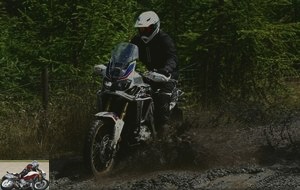
Certainly, probably few Africa Twin owners will put it to the test to this extent on this type of greasy and muddy playground. But if it is already astonishing to realize that, correctly shod, a trail can be freed from real difficulties, this observation is then reinforced by the delicacy of the electronic aids. The choice of a manual or automatic transmission is a plus to better match the personality and expectations of the buyer, but at Honda, we are growing (rightly) in the development of DCT. While forecasts hovered around 40%, the DCT equips just over 50% of European Africa Twins and we can expect to see this type of transmission arriving soon on other families of motorcycles..

Last good point: the effectiveness of the crankcases and fairing protections: on these machines belonging to the TT driving school of the Honda Adventure Center and called upon to fall regularly, there are few signs of premature aging! What to go to play in the woods, a free spirit !

Strong points
- Chassis balance
- Excellent suspensions
- Smooth, docile, torquey engine
- Fine traction control
- Real contribution of DCT even in TT
- Solid protections
Weak points
- Inability to change the level of traction control while driving
- It’s more complicated for short legs
The Africa Twin technical sheet
Test conditions
- Itinerary: a full day of testing at the Honda Adventure Center in Wales with quadruple motocross world champion Dave Thorpe as instructor.
- Motorcycle mileage: 2000 km
- Problem encountered: normally mud is good for the skin, but I didn’t even fall once…
Related articles
-
Efficient charmer Alongside its NC700s (New Concept), Honda presented in 2012 a hybrid machine, very close in part-cycle and mechanical parts of its…
-
Honda Africa Twin CRF1000L test
Honda CRF1000L Africa Twin ABS and DCT version Legends never die. Like the phoenix, the Africa Twin is reborn from the sand of its past exploits in a…
-
Honda renews its big roadster. Retro, sporty, or both ? 4 cylinders in line, 998 cm3, 145 hp at 10,500 rpm, 104 Nm at 8,250 rpm, 212 kilos with full…
-
Some subtle changes for the 2018 version of the trail In-line twin, 998 cm3, 95 hp at 7,500 rpm, 98 Nm at 6,000 rpm, from 237 kilos, from 13,549 € The…
-
The trail for all Completely revised both in terms of aesthetics and part cycle, the new VFR800X Crossrunner asserts itself through an efficient,…
-
Face to face with the 2016 DCT and ABS trail versus the 2001 vintage Saga Africa As a reminder, the origin of the Africa Twin is a prototype, the NXR 750…
-
Single cylinder 4-T, 25 hp at 8,500 rpm, 22.6 Nm at 6,750 Nm, 146 kilos fully loaded The Knacki Herta spirit of the motorcycle for 4999 € You have…
-
In-line twin, 471 cm3, 45 hp at 8,500 rpm, 44.6 Nm at 6,000 rpm, 190 kilos, € 6,299 A small accessible bobber intended for A2 licenses on a mechanical…
-
The return of simple pleasures Good news for dynamic riders, the sport touring segment seems to be expanding again. Some already hold the pavement for a…
-
The small large gas turbine The brand’s historic sports car, the CBR 600 RR is a sure bet for efficiency and performance. Rather than the ultimate quest…